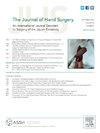Opponensplasty With Abductor Pollicis Brevis Rerouting for Types II and IIIA Hypoplastic Thumbs
IF 2.1
2区 医学
Q2 ORTHOPEDICS
引用次数: 0
Abstract
Purpose
To evaluate the functional results after opponensplasty using an abductor pollicis brevis rerouting technique in type II and IIIA hypoplastic thumbs.
Methods
Eleven hypoplastic thumbs in nine children with type II and IIIA hypoplastic thumbs were treated with abductor pollicis brevis rerouting. The mean follow-up period was 70 months (range, 12–172 months). We assessed preoperative to postoperative changes in the angles of the first and second metacarpal axes and the longitudinal axis of the first metacarpal and proximal thumb phalanx as well as grip and pinch strengths.
Results
The mean angle of the first and second metacarpal axes showed a significant improvement to 64° (range, 47° to 89°), and the mean angle of the first metacarpal and proximal phalanx of the thumb showed a significant reduction to 8° (range, 1° to 21°) after surgery. The mean postoperative grip and pinch strengths were 77% (range, 63% to 106%) and 72.0% (range, 33% to 97%), respectively, relative to the unaffected side.
Conclusions
Abductor pollicis brevis rerouting for type II and IIIA hypoplastic thumbs can produce joint stability and a strong pronation effect in addition to the opponens function.
Type of study/level of evidence
Therapeutic V.
针对 II 型和 IIIA 型拇指发育不良的拇指外展成形术和拇指内收肌重塑术。
目的评价外展拇趾短转径技术治疗II型和IIIA型发育不全拇指对手成形术后的功能效果。方法对9例II型和IIIA型拇指发育不全患儿行拇外展短支复路治疗。平均随访70个月(范围12-172个月)。我们评估了术前至术后第一、第二掌骨轴角度、第一掌骨和拇指近端指骨纵轴以及握力和捏力的变化。结果术后第一、第二掌骨的平均角度明显改善至64°(范围47°~ 89°),第一掌骨与拇指近端指骨的平均角度明显降低至8°(范围1°~ 21°)。相对于未患侧,术后平均握力和捏力分别为77%(范围,63%至106%)和72.0%(范围,33%至97%)。结论拇拇短截肌改道治疗II型和IIIA型发育不全拇指,除能恢复对手功能外,还能提高关节稳定性和较强的旋前效果。研究类型/证据水平
本文章由计算机程序翻译,如有差异,请以英文原文为准。
求助全文
约1分钟内获得全文
求助全文
来源期刊
CiteScore
3.20
自引率
10.50%
发文量
402
审稿时长
12 weeks
期刊介绍:
The Journal of Hand Surgery publishes original, peer-reviewed articles related to the pathophysiology, diagnosis, and treatment of diseases and conditions of the upper extremity; these include both clinical and basic science studies, along with case reports. Special features include Review Articles (including Current Concepts and The Hand Surgery Landscape), Reviews of Books and Media, and Letters to the Editor.

 求助内容:
求助内容: 应助结果提醒方式:
应助结果提醒方式:


